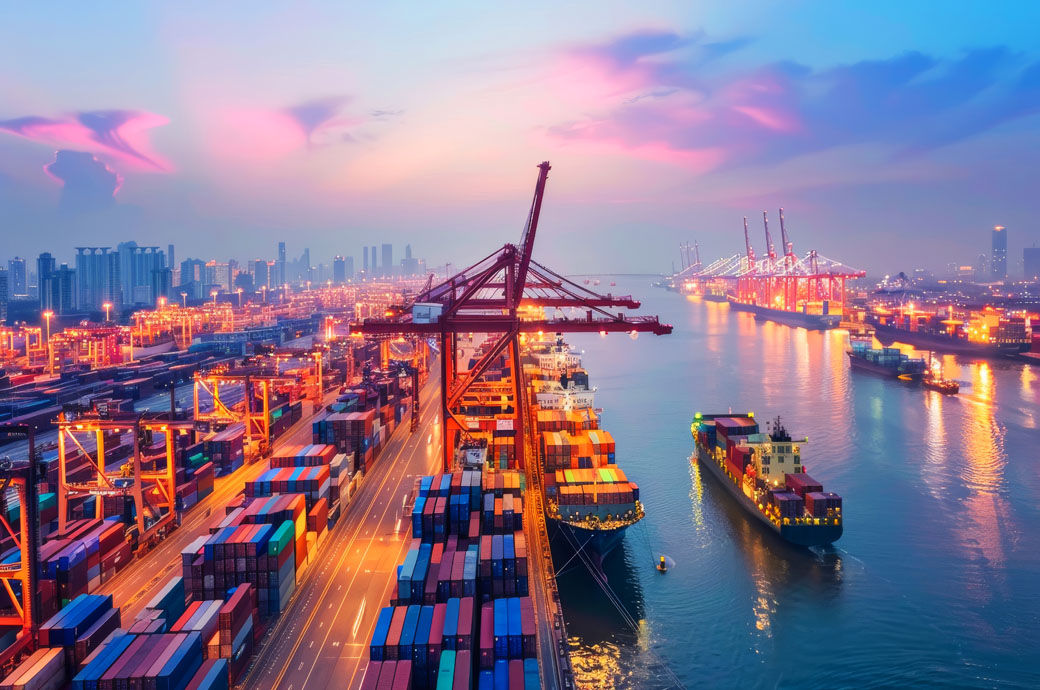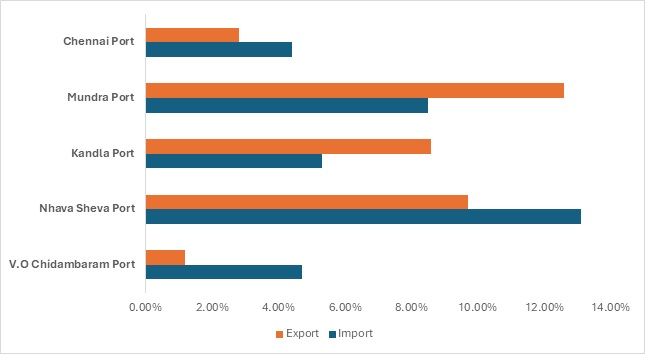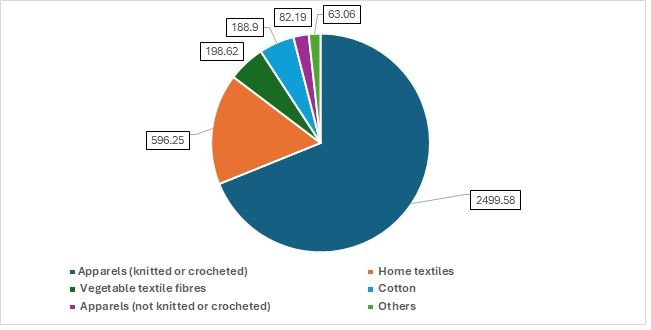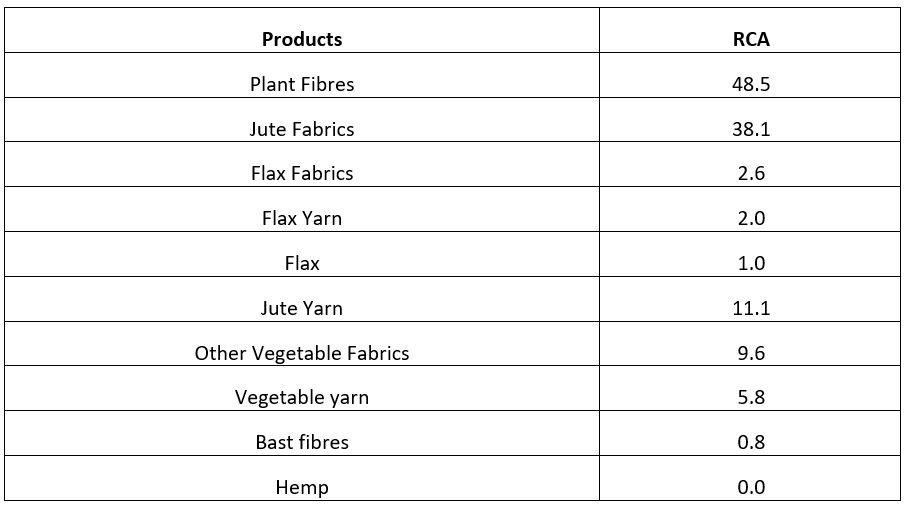
Notably, Tamil Nadu, which encompasses the Southern region, is home to a highly productive textile industry. Indian textiles are in high demand in Western markets, generating significant revenue and showcasing the country's manufacturing capabilities. Key hubs such as Tiruppur, Coimbatore, Karur, Erode, and Salem form the backbone of the textile value chain, contributing to India’s reputation as a leading player in this sector. The opening of the Tuticorin terminal is expected to streamline logistics and strengthen India’s competitive edge in the global textile trade, further bolstering its economic growth.
Exhibit 1: Current port capacities of Indian ports (in %)

Source: Port Watch, F2F Analysis
The data highlights V.O. Chidambaram Port's performance in comparison to other major ports regarding import and export percentages. With an import rate of 4.70 per cent and an export rate of 1.20 per cent, V.O. Chidambaram Port has relatively lower figures compared to its peers. For instance, Nhava Sheva Port shows significantly higher import (13.10 per cent) and export (9.70 per cent) rates, indicating its dominance in trade activity. Kandla and Mundra ports also exhibit stronger export performance, especially Mundra, with 12.60 per cent. This suggests that V.O. Chidambaram Port may need to enhance its operational capabilities and marketing strategies to attract more export activity and compete effectively in the region. The lower export percentage signals potential opportunities for growth and development in attracting exporters.
Despite recent challenges in export performance, textile products consistently rank among the top five exports from Tuticorin Sea Port. This underscores the Southern region of India, particularly Tamil Nadu, as a critical hub for textile exporters reliant on this port for their international shipments. Leading the list of traded products are ready-made garments made from cotton, followed closely by ready-made garments crafted from other textile materials and cotton yarn.
Ready-made garments, as value-added products, command higher prices in the global market, positioning Tamil Nadu's textiles favourably. The new terminal at Tuticorin is expected to significantly enhance export capabilities, facilitating greater access to major markets such as the US, the UK, and Mediterranean countries, all of which are prominent consumers of high-quality textile goods from India. This development not only promises to boost Tamil Nadu’s export figures but also strengthens its reputation in the global textile industry.
Exhibit 2: Tamil Nadu’s top 5 exported products (in $ mn)

Source: TexPro, F2F Analysis
The export data for textiles from Tamil Nadu, categorised by HS codes, reveals a diverse range of values, highlighting the state's robust textile industry. The highest export value is associated with HS code 61, amounting to $2,499.58 million, indicating a strong demand for this category, likely comprising knitted or crocheted garments. HS code 63 follows with $596.25 million, showcasing significant activity in other textile products. Codes 53 and 52, with values of $198.62 million and $188.90 million, respectively, suggest a healthy export performance in plant-based textiles and fabric materials. While lower in value, HS codes 62, at $82.19 million, and 60, at $63.06 million, still contribute meaningfully to the overall textile export portfolio. Overall, the data underscores Tamil Nadu's strategic position in the global textile market, with potential growth opportunities in various subcategories.
Emergence of natural fibres demand
The rising demand for natural fibres, such as jute, flax, and other textile bast fibres, marks a significant shift towards sustainable materials in the textile industry. These fibres, derived from plants, offer an eco-friendly alternative to synthetic textiles, aligning with growing consumer demand for environmentally responsible products. Jute, known for its strength and versatility, has been used for centuries in applications ranging from burlap sacks to stylish home decor. Flax, the source of linen, is celebrated not only for its durability but also for its biodegradable properties. Other fibres, like hemp, ramie, and abaca, are gaining traction due to their unique qualities, such as moisture-wicking and antimicrobial properties. As industries strive to reduce their carbon footprint, the revival and innovation surrounding these natural fibres reflect a broader commitment to sustainability, combining tradition with modern design to create a more responsible future in textiles.
The focus here is on natural fibres and fabrics, one of the most prominent export materials from the Tamil Nadu region. Europe is highlighted as a key market due to its direct connectivity to V.O. Chidambaram Port and its growing emphasis on sustainability in the textile sector.
Table 1: India’s revealed comparative advantage (RCA) with European Union in natural fibres, yarn and fabrics

Source: DGCIS, TexPro, F2F Analysis
The RCA of Indian textile products for CY 2024 in Europe highlights significant strengths in several categories, particularly in plant fibres and jute fabrics. With an RCA value of 48.5, plant fibres emerge as the most competitive segment, indicating strong demand for these sustainable materials in European markets. Jute fabrics also demonstrate robust performance, with an RCA of 38.1, reflecting their popularity due to their eco-friendliness and versatility. Flax fabrics and flax yarn, while having lower RCA values of 2.6 and 2.0 respectively, still maintain a niche market presence.
Other vegetable fabrics and vegetable yarn show moderate RCAs of 9.6 and 5.8, suggesting opportunities for growth and expansion. In contrast, bast fibres (0.8) and hemp (0.0) have lower RCA values, indicating challenges in these areas, possibly due to limited market penetration or competition from alternative sources. Overall, the data underscores India’s strong position in the European textile market, particularly in sustainable and natural fibre products, while also identifying areas where strategic efforts could enhance competitiveness.
Way Forward
The inauguration of the new terminal at the Tuticorin port is set to boost exports and significantly reduce trade costs. The Ministry of Shipping estimates that freight costs could decrease by approximately $200, providing substantial relief to exporters. According to Freightos, the cost of a full container load of textiles currently ranges from $5,000 to $6,000, meaning this reduction would lower costs to around $4,800 to $5,800. For textiles exported from southern India, which often occupy less than a full container load, this could result in savings of $500 to $800.
Europe's increasing focus on sustainability presents a lucrative opportunity for Indian textiles, particularly in the market for vegetable fibres and fabrics. With cotton being the predominant natural fibre, India is a leading player in the textile industry. The country’s rich agricultural resources, fertile land, and capacity to produce high-quality textiles from natural materials position it well for growth in the international market.
The development of enhanced port infrastructure not only strengthens India’s textile export capabilities but also paves the way for the country to become a leader in pioneering new-age textiles. This progress could further solidify India’s reputation in the global textile arena, especially as demand for sustainable and innovative textile solutions continues to rise.
ALCHEMPro News Desk (NS)
Receive daily prices and market insights straight to your inbox. Subscribe to AlchemPro Weekly!